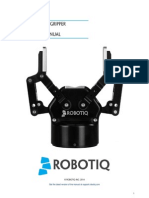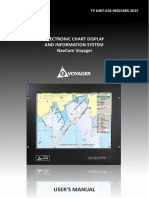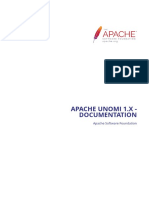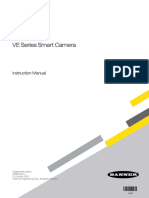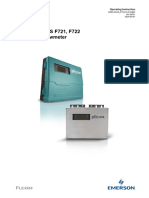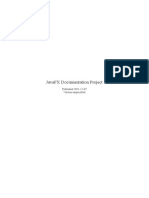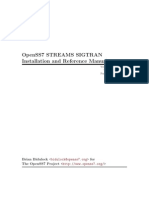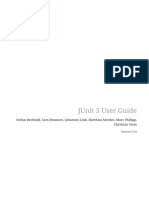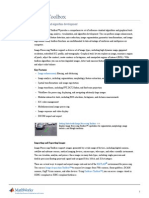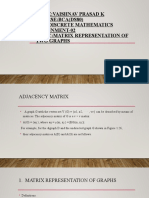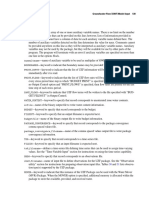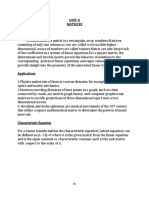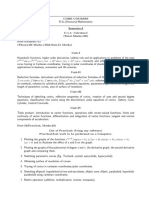ANSYS, Inc. Documentation Errata
ANSYS, Inc. Documentation Errata
Uploaded by
Hiếu NguyễnCopyright:
Available Formats
ANSYS, Inc. Documentation Errata
ANSYS, Inc. Documentation Errata
Uploaded by
Hiếu NguyễnOriginal Title
Copyright
Available Formats
Share this document
Did you find this document useful?
Is this content inappropriate?
Copyright:
Available Formats
ANSYS, Inc. Documentation Errata
ANSYS, Inc. Documentation Errata
Uploaded by
Hiếu NguyễnCopyright:
Available Formats
ANSYS, Inc.
Documentation Errata
Release 14.0 ANSYS, Inc.
February 2012 Southpointe
275 Technology Drive 002914
Canonsburg, PA 15317
ansysinfo@ansys.com
http://www.ansys.com
(T) 724-746-3304
(F) 724-514-9494
Table of Contents
Documentation Errata . . . . . . . . . . . . . . . . . . . . . . . . . . . . . . . . . . . . . . . . . . . . . . . . . . . . . . . . . . . . . . . . . . . . . . . . . . . . . . . . . . . . . . . . . . . . . . . . . . . . . . . . . . . . . . . . . . . . . . . . . . . . . . . . . . 1
1. ANSYS, Inc. Release Notes . . . . . . . . . . . . . . . . . . . . . . . . . . . . . . . . . . . . . . . . . . . . . . . . . . . . . . . . . . . . . . . . . . . . . . . . . . . . . . . . . . . . . . . . . . . . . . . . . . . . . . . . . . . . . . . . . . . . 1
1.1. Workbench . . . . . . . . . . . . . . . . . . . . . . . . . . . . . . . . . . . . . . . . . . . . . . . . . . . . . . . . . . . . . . . . . . . . . . . . . . . . . . . . . . . . . . . . . . . . . . . . . . . . . . . . . . . . . . . . . . . . . . . . . . . . . . . . . 1
1.1.1. Meshing Application Release Notes . . . . . . . . . . . . . . . . . . . . . . . . . . . . . . . . . . . . . . . . . . . . . . . . . . . . . . . . . . . . . . . . . . . . . . . . . . . . . . . . . . . . 1
1.2. Mechanical APDL Release Notes . . . . . . . . . . . . . . . . . . . . . . . . . . . . . . . . . . . . . . . . . . . . . . . . . . . . . . . . . . . . . . . . . . . . . . . . . . . . . . . . . . . . . . . . . . . . . . . . . . 1
2. Mechanical APDL . . . . . . . . . . . . . . . . . . . . . . . . . . . . . . . . . . . . . . . . . . . . . . . . . . . . . . . . . . . . . . . . . . . . . . . . . . . . . . . . . . . . . . . . . . . . . . . . . . . . . . . . . . . . . . . . . . . . . . . . . . . . . . . . 1
2.1. Basic Analysis Guide . . . . . . . . . . . . . . . . . . . . . . . . . . . . . . . . . . . . . . . . . . . . . . . . . . . . . . . . . . . . . . . . . . . . . . . . . . . . . . . . . . . . . . . . . . . . . . . . . . . . . . . . . . . . . . . . . . . 1
2.2. Parallel Processing Guide . . . . . . . . . . . . . . . . . . . . . . . . . . . . . . . . . . . . . . . . . . . . . . . . . . . . . . . . . . . . . . . . . . . . . . . . . . . . . . . . . . . . . . . . . . . . . . . . . . . . . . . . . . . . 2
2.3. Technology Demonstration Guide . . . . . . . . . . . . . . . . . . . . . . . . . . . . . . . . . . . . . . . . . . . . . . . . . . . . . . . . . . . . . . . . . . . . . . . . . . . . . . . . . . . . . . . . . . . . . . . 2
2.4. Programmers Manual . . . . . . . . . . . . . . . . . . . . . . . . . . . . . . . . . . . . . . . . . . . . . . . . . . . . . . . . . . . . . . . . . . . . . . . . . . . . . . . . . . . . . . . . . . . . . . . . . . . . . . . . . . . . . . . . . 2
3. Mechanical Applications . . . . . . . . . . . . . . . . . . . . . . . . . . . . . . . . . . . . . . . . . . . . . . . . . . . . . . . . . . . . . . . . . . . . . . . . . . . . . . . . . . . . . . . . . . . . . . . . . . . . . . . . . . . . . . . . . . . . . . 5
3.1. Mechanical Application User's Guide . . . . . . . . . . . . . . . . . . . . . . . . . . . . . . . . . . . . . . . . . . . . . . . . . . . . . . . . . . . . . . . . . . . . . . . . . . . . . . . . . . . . . . . . . . . 5
3.1.1. Path (Construction Geometry) . . . . . . . . . . . . . . . . . . . . . . . . . . . . . . . . . . . . . . . . . . . . . . . . . . . . . . . . . . . . . . . . . . . . . . . . . . . . . . . . . . . . . . . . . . . . 5
3.1.2. Setting Up Boundary Conditions . . . . . . . . . . . . . . . . . . . . . . . . . . . . . . . . . . . . . . . . . . . . . . . . . . . . . . . . . . . . . . . . . . . . . . . . . . . . . . . . . . . . . . . . 5
3.1.3. Pipe Temperature . . . . . . . . . . . . . . . . . . . . . . . . . . . . . . . . . . . . . . . . . . . . . . . . . . . . . . . . . . . . . . . . . . . . . . . . . . . . . . . . . . . . . . . . . . . . . . . . . . . . . . . . . . . . . . . 5
3.1.4. Design Assessment Example Files . . . . . . . . . . . . . . . . . . . . . . . . . . . . . . . . . . . . . . . . . . . . . . . . . . . . . . . . . . . . . . . . . . . . . . . . . . . . . . . . . . . . . . . 5
3.1.5. 2D Rigid Bodies . . . . . . . . . . . . . . . . . . . . . . . . . . . . . . . . . . . . . . . . . . . . . . . . . . . . . . . . . . . . . . . . . . . . . . . . . . . . . . . . . . . . . . . . . . . . . . . . . . . . . . . . . . . . . . . . . . 6
4. Meshing . . . . . . . . . . . . . . . . . . . . . . . . . . . . . . . . . . . . . . . . . . . . . . . . . . . . . . . . . . . . . . . . . . . . . . . . . . . . . . . . . . . . . . . . . . . . . . . . . . . . . . . . . . . . . . . . . . . . . . . . . . . . . . . . . . . . . . . . . . . . . . 6
4.1. Meshing User's Guide . . . . . . . . . . . . . . . . . . . . . . . . . . . . . . . . . . . . . . . . . . . . . . . . . . . . . . . . . . . . . . . . . . . . . . . . . . . . . . . . . . . . . . . . . . . . . . . . . . . . . . . . . . . . . . . . . 6
4.1.1. Assembly Meshing Group of Controls . . . . . . . . . . . . . . . . . . . . . . . . . . . . . . . . . . . . . . . . . . . . . . . . . . . . . . . . . . . . . . . . . . . . . . . . . . . . . . . . . 6
4.1.2. Method . . . . . . . . . . . . . . . . . . . . . . . . . . . . . . . . . . . . . . . . . . . . . . . . . . . . . . . . . . . . . . . . . . . . . . . . . . . . . . . . . . . . . . . . . . . . . . . . . . . . . . . . . . . . . . . . . . . . . . . . . . . . . 6
4.1.3. The Assembly Meshing Workflow . . . . . . . . . . . . . . . . . . . . . . . . . . . . . . . . . . . . . . . . . . . . . . . . . . . . . . . . . . . . . . . . . . . . . . . . . . . . . . . . . . . . . . . 7
4.1.4. Setting Prerequisites . . . . . . . . . . . . . . . . . . . . . . . . . . . . . . . . . . . . . . . . . . . . . . . . . . . . . . . . . . . . . . . . . . . . . . . . . . . . . . . . . . . . . . . . . . . . . . . . . . . . . . . . . . 7
4.1.5. Defining Virtual Bodies . . . . . . . . . . . . . . . . . . . . . . . . . . . . . . . . . . . . . . . . . . . . . . . . . . . . . . . . . . . . . . . . . . . . . . . . . . . . . . . . . . . . . . . . . . . . . . . . . . . . . . . 8
4.1.6. Notes on Virtual Bodies . . . . . . . . . . . . . . . . . . . . . . . . . . . . . . . . . . . . . . . . . . . . . . . . . . . . . . . . . . . . . . . . . . . . . . . . . . . . . . . . . . . . . . . . . . . . . . . . . . . . . . 8
4.1.7. Generating the Mesh . . . . . . . . . . . . . . . . . . . . . . . . . . . . . . . . . . . . . . . . . . . . . . . . . . . . . . . . . . . . . . . . . . . . . . . . . . . . . . . . . . . . . . . . . . . . . . . . . . . . . . . . . . 8
4.1.8. Inspecting Large Meshes Using Named Selections . . . . . . . . . . . . . . . . . . . . . . . . . . . . . . . . . . . . . . . . . . . . . . . . . . . . . . . . . . . . . . 8
5. FLUENT . . . . . . . . . . . . . . . . . . . . . . . . . . . . . . . . . . . . . . . . . . . . . . . . . . . . . . . . . . . . . . . . . . . . . . . . . . . . . . . . . . . . . . . . . . . . . . . . . . . . . . . . . . . . . . . . . . . . . . . . . . . . . . . . . . . . . . . . . . . . . . . 9
5.1. FLUENT Users Guide . . . . . . . . . . . . . . . . . . . . . . . . . . . . . . . . . . . . . . . . . . . . . . . . . . . . . . . . . . . . . . . . . . . . . . . . . . . . . . . . . . . . . . . . . . . . . . . . . . . . . . . . . . . . . . . . . . . 9
5.1.1. Section 9.1.2 UDS Theory . . . . . . . . . . . . . . . . . . . . . . . . . . . . . . . . . . . . . . . . . . . . . . . . . . . . . . . . . . . . . . . . . . . . . . . . . . . . . . . . . . . . . . . . . . . . . . . . . . . . 9
5.2. FLUENT Tutorial Guide . . . . . . . . . . . . . . . . . . . . . . . . . . . . . . . . . . . . . . . . . . . . . . . . . . . . . . . . . . . . . . . . . . . . . . . . . . . . . . . . . . . . . . . . . . . . . . . . . . . . . . . . . . . . . . . . 9
5.2.1. Tutorial 13: Using the Mixing Plane Model . . . . . . . . . . . . . . . . . . . . . . . . . . . . . . . . . . . . . . . . . . . . . . . . . . . . . . . . . . . . . . . . . . . . . . . . . . . 9
6. EKM Desktop . . . . . . . . . . . . . . . . . . . . . . . . . . . . . . . . . . . . . . . . . . . . . . . . . . . . . . . . . . . . . . . . . . . . . . . . . . . . . . . . . . . . . . . . . . . . . . . . . . . . . . . . . . . . . . . . . . . . . . . . . . . . . . . . . . . . . . . 9
6.1. EKM Desktop Users Guide . . . . . . . . . . . . . . . . . . . . . . . . . . . . . . . . . . . . . . . . . . . . . . . . . . . . . . . . . . . . . . . . . . . . . . . . . . . . . . . . . . . . . . . . . . . . . . . . . . . . . . . . . . 9
6.1.1. Section 8.6.1 Using the Send Changes Wizard . . . . . . . . . . . . . . . . . . . . . . . . . . . . . . . . . . . . . . . . . . . . . . . . . . . . . . . . . . . . . . . . . . . . . . . 9
7. RSM . . . . . . . . . . . . . . . . . . . . . . . . . . . . . . . . . . . . . . . . . . . . . . . . . . . . . . . . . . . . . . . . . . . . . . . . . . . . . . . . . . . . . . . . . . . . . . . . . . . . . . . . . . . . . . . . . . . . . . . . . . . . . . . . . . . . . . . . . . . . . . . . . . . . 9
7.1. RSM Online Help . . . . . . . . . . . . . . . . . . . . . . . . . . . . . . . . . . . . . . . . . . . . . . . . . . . . . . . . . . . . . . . . . . . . . . . . . . . . . . . . . . . . . . . . . . . . . . . . . . . . . . . . . . . . . . . . . . . . . . . . . 9
7.1.1. Section 2.2.4.3. Computers with Multiple Network Interface Cards (NIC) . . . . . . . . . . . . . . . . . . . . . . . . . . . . . . . . . . . 9
8. ANSYS Workbench . . . . . . . . . . . . . . . . . . . . . . . . . . . . . . . . . . . . . . . . . . . . . . . . . . . . . . . . . . . . . . . . . . . . . . . . . . . . . . . . . . . . . . . . . . . . . . . . . . . . . . . . . . . . . . . . . . . . . . . . . . . . . 10
8.1. Workbench User Guide . . . . . . . . . . . . . . . . . . . . . . . . . . . . . . . . . . . . . . . . . . . . . . . . . . . . . . . . . . . . . . . . . . . . . . . . . . . . . . . . . . . . . . . . . . . . . . . . . . . . . . . . . . . . . 10
8.2. Workbench Scripting Guide . . . . . . . . . . . . . . . . . . . . . . . . . . . . . . . . . . . . . . . . . . . . . . . . . . . . . . . . . . . . . . . . . . . . . . . . . . . . . . . . . . . . . . . . . . . . . . . . . . . . . . 10
9. AUTODYN . . . . . . . . . . . . . . . . . . . . . . . . . . . . . . . . . . . . . . . . . . . . . . . . . . . . . . . . . . . . . . . . . . . . . . . . . . . . . . . . . . . . . . . . . . . . . . . . . . . . . . . . . . . . . . . . . . . . . . . . . . . . . . . . . . . . . . . . . . 10
9.1. AUTODYN Parallel Processing Tutorial . . . . . . . . . . . . . . . . . . . . . . . . . . . . . . . . . . . . . . . . . . . . . . . . . . . . . . . . . . . . . . . . . . . . . . . . . . . . . . . . . . . . . . . . 10
9.2. AUTODYN User Subroutines Tutorial . . . . . . . . . . . . . . . . . . . . . . . . . . . . . . . . . . . . . . . . . . . . . . . . . . . . . . . . . . . . . . . . . . . . . . . . . . . . . . . . . . . . . . . . . . 10
iii
Release 14.0 - SAS IP, Inc. All rights reserved. - Contains proprietary and confidential information
of ANSYS, Inc. and its subsidiaries and affiliates.
Release 14.0 - SAS IP, Inc. All rights reserved. - Contains proprietary and confidential information
of ANSYS, Inc. and its subsidiaries and affiliates.
iv
Documentation Errata
1. ANSYS, Inc. Release Notes
1.1. Workbench
1.1.1. Meshing Application Release Notes
The following incorrect statement appears in the section ANSYS, Inc. Release Notes > Workbench >
Meshing Application Release Notes:
The Assembly Meshing group of global mesh controls is now available. You can use
one of the controls, called Method, to choose either CutCell or Tetrahedrons as your
strategy for assembly meshing. CutCell is available only in the Meshing application, and
only when Physics Preference is set to CFD and Solver Preference is set to Fluent.
Tetrahedrons is available in both the Meshing application and the Mechanical application,
regardless of Physics Preference and Solver Preference settings.
This statement should be corrected as follows:
The Assembly Meshing group of global mesh controls is now available, but it is exposed
only when Physics Preference is set to CFD and Solver Preference is set to Fluent.
You can use one of the controls, called Method, to choose either CutCell or Tetrahed-
rons as your strategy for assembly meshing. CutCell is available only in the Meshing
application, while Tetrahedrons is available in both the Meshing application and the
Mechanical application. Once you have selected CutCell or Tetrahedrons, the Physics
Preference and Solver Preference fields are grayed out (uneditable) and remain that
way unless you change Method to None.
1.2. Mechanical APDL Release Notes
The following release note entry was omitted from the section ANSYS, Inc. Release Notes > Mech-
anical APDL > Structural > Contact > Other Contact Enhancements:
The accuracy of MPC bonded contact has been improved for the case of initial gaps or penet-
rations between the bonded surfaces. In particular, near-zero frequencies are obtained in free-
free modal analyses.
2. Mechanical APDL
2.1. Basic Analysis Guide
Within the Basic Analysis Guide at Solution> Restarting an Analysis> Multiframe Restart> Multiframe
Restart Requirements> Multiframe Restart Limitations, the following item should be included:
The first time step of a restarted transient solution using the HHT algorithm (TRNOPT) uses the
Newmark algorithm. Subsequent time steps will use the HHT algorithm. (22047)
1
Release 14.0 - SAS IP, Inc. All rights reserved. - Contains proprietary and confidential information
of ANSYS, Inc. and its subsidiaries and affiliates.
2.2. Parallel Processing Guide
In the Parallel Processing Guide under Prerequisites for Running Distributed ANSYS, Table 4.2 Platforms
and MPI Software lists an incorrect version number for the Intel MPI software used on Windows platforms.
The correct version number is Intel MPI 4.0.2.
2.3. Technology Demonstration Guide
In the Technology Demonstration Guide under About This Guide, an incorrect path is given (in Obtaining
the Input Files) for the location of the input files used in the technology demonstration problems. The
correct path is: \Program Files\ANSYS Inc\v140\ansys\data\techdemo
2.4. Programmers Manual
In the Programmer's Manual under Creating a New Element via the User-Defined Element API, the
UserElem subroutine that is listed is incorrect. The correct UserElem subroutine is shown below:
*deck,UserElem USERDISTRIB
subroutine UserElem (elId, matId, keyMtx, lumpm, nDim, nNodes,
& Nodes, nIntPnts, nUsrDof, kEStress,
& keyAnsMat, keySym, nKeyOpt, KeyOpt,
& temper, temperB, tRef, kTherm,
& nPress, Press, kPress, nReal, RealConst,
& nSaveVars, saveVars, xRef, xCur,
& TotValDofs, IncValDofs, ItrValDofs,
& VelValDofs, AccValDofs,
& kfstps, nlgeom, nrkey, outkey, elPrint, iott,
& keyHisUpd, ldstep, isubst, ieqitr, timval,
& keyEleErr, keyEleCnv,
& eStiff, eMass, eDamp, eSStiff,
& fExt, fInt, elVol, elMass, elCG,
& nRsltBsc, RsltBsc, nRsltVar, RsltVar,
& nElEng, elEnergy)
&
c*************************************************************************
c
c *** Primary function: General User Element Subroutine
c *** Note:
c This routine is completed with an example, see more details later.
c
c
c PROGRAMMER SHOULD NOT CHANGE ANY PURE INPUT ARGUMENTS (marked by ....,in)!
c
c elId (int,sc,in) element number
c matId (int,sc,in) material number of this element
c keyMtx (int,ar(10),in) matrix and load vector form requests
c 0 = not requested, 1 = requested
c see below for more details
c lumpm (int,sc,in) mass matrix format
c = 0 no lumped mass matrix
c = 1 lumped mass matrix
c nDim (int,sc,in) number of dimensions of the problem
c (defined on USRELEM command as NDIM)
c = 2 2D
c = 3 3D
c nNodes (int,sc,in) number of nodes of the element
c (defined on USRELEM command as NNODES)
c Nodes (int,ar(nNodes),in)node list of this element
c nIntPnts (int,sc,in) maximum number of integration points
c (defined on USRELEM command as NINTPNTS)
c nUsrDof (int,sc,in) number of DOFs of this element (matrix and
c load vector size)
c kEStress (int,sc,in) kEStress
c (defined on USRELEM command as KESTRESS)
c keyAnsMat (int,sc,in) key to indicate if ANSYS material
Release 14.0 - SAS IP, Inc. All rights reserved. - Contains proprietary and confidential information
of ANSYS, Inc. and its subsidiaries and affiliates.
2
Documentation Errata
c routine is going to be called
c (defined on USRELEM command as KEYANSMAT)
c = 0, No
c = 1, Yes
c keySym (int,sc,in) key to indicate if element matrices
c is symmetric
c (defined on USRELEM command as KEYSYM)
c = 0, symmetric
c = 1, unsymmetric
c nKeyOpt (int,sc,in) number of element key options able to be
c used in this routine
c KeyOpt (int,ar(nKeyOpt),in) values of element key option defined
c by et or keyopt command for the
c user elements, only the first
c nKeyOpt values are passed in and can
c be used to branch the routine for
c different formulations
c temper (dp,ar(nNodes),in) nodal temperatures at current time
c temperB (dp,ar(nNodes),in) nodal temperatures at the beginning of this
c incremental step (substep)
c tRef (dp,sc,in) reference temperature
c kTherm (int,sc,inout) input: flag for thermal loading
c = 1, Temperatures at nodes are different
c from the reference temperature,
c thermal loading might be needed.
c = 0, Temperatures at nodes are the same
c as the reference temperature,
c thermal loading is not needed.
c output: flag for thermal strains
c nPress (int,sc,in) number of pressure values for this element
c Press (dp,ar(nPress),in) applied elemental face load (pressure)
c kPress (int,sc,in) flag for pressure loading
c = 1, pressure load is applied and
c equivalent nodal forces should be
c calculated
c = 0, no pressure loading
c nReal (int,sc,in) number of real constants
c (defined on USRELEM command as NREAL)
c RealConst (dp,ar(nReal),in) user defined real constants
c nSaveVars (int,sc,in) number of saved variables
c (defined on USRELEM command as NSAVEVARS)
c saveVars (dp,ar(nSaveVars),inout) user saved variables
c xRef (dp,ar(nDim,nNodes),in)
c nodal coordinates in initial configuration
c xCur (dp,ar(nDim,nNodes),in)
c nodal coordinates in current configuration
c TotValDofs (dp,ar(nUsrDof),in) total values of DOFs (displacements)
c from time = 0
c IncValDofs (dp,ar(nUsrDof),in) incremental values of DOFs (displacements)
c for the current step
c ItrValDofs (dp,ar(nUsrDof),in) iterative values of DOFs (displacements)
c for the current iteration
c (normally needed for debug only)
c VelValDofs (dp,ar(nUsrDof),in) first time derivatives of DOFs
c (velocities) (normally not needed)
c AccValDofs (dp,ar(nUsrDof),in) second time derivatives of DOFs
c (accelerations) (normally not needed)
c kfstps (int,sc,in) key for the first iteration of first
c substep of the first load step
c = 1 yes
c = 0 no
c nlgeom (int,sc,in) large deformation key [from nlgeom command]
c = 0 NLGEOM,OFF
c = 1 NLGEOM, ON
c nrkey (int,sc,in) key to indicate a newton-raphson
c (incremental) procedure
c = 0 No
c = 1 Yes
c outkey (int,sc,in) key to indicate if any element output is
c to be placed on the print file or the
c result file
c = 0 No
3
Release 14.0 - SAS IP, Inc. All rights reserved. - Contains proprietary and confidential information
of ANSYS, Inc. and its subsidiaries and affiliates.
Mechanical APDL
c = 1 Yes
c elPrint (int,sc,in) key to indicate if any element output is
c to be placed on the print file
c = 0 No
c = 1 Yes
c iott (int,sc,in) print output file unit number
c keyHisUpd (int,sc,in) key to indicate if history-dependent
c variables need to be updated, like
c equivalent plastic strain, back stress
c etc. since the iteration is already
c converged
c = 0 not converged, don't need to update
c history dependent variables
c = 1 yes, converged, need to update
c history dependent variables
c
c --- The following 7 variable group can usually be ignored.
c --- The variables are used for debug, timing, and convergence control.
c ldstep (int,sc,in) current load step number
c isubst (int,sc,in) current substep number
c ieqitr (int,sc,in) current equilibium iteration number
c timval (int,sc,in) current time value
c keyEleErr (int,sc,inout) key to indicate if there is any element
c formulation error, like negative Jacobian.
c The error could be caused by too
c large incremental step, illegal model.
c = 0 no error (preset value before calling)
c = 1 some error happens. ANSYS will
c decide to stop the analysis or cutback
c the substep (bi-section) based on other
c user input and information at higher
c level.
c keyEleCnv (int,sc,inout) key to flag if this element satisfies
c the user defined element convergence
c criterion.
c = 1, yes, the criterion is satisfied
c or don't have any criterion at all
c it is preset value before calling
c = 0, no, the element doesn't satisfy
c element convergence criterion. If
c this is the case, the iteration will
c not converge even when both force
c and displacement converge
c ---- end of 7 variable group -----
c
c requested if
c eStiff(dp,ar(nUsrDof,nUsrDof),inout) stiffness matrix keyMtx(1)=1
c eMass (dp,ar(nUsrDof,nUsrDof),inout) mass matrix keyMtx(2)=1
c eDamp (dp,ar(nUsrDof,nUsrDof),inout) damping matrix keyMtx(3)=1
c eSStiff(dp,ar(nUsrDof,nUsrDof),inout)stress stiffness matrix keyMtx(4)=1
c fExt (dp,ar(nUsrDof),out) applied f vector keyMtx(5)=1
c fInt (dp,ar(nUsrDof),out) internal force vector keyMtx(6)=1
c elVol (dp,sc,out) element volume
c elMass (dp,sc,out) element mass
c elCG (dp,ar(3),out) element centroid coordinates in current
c configuration
c nRsltBsc (dp,sc,in) number of basic elemental results saved in
c result files
c RsltBsc (dp,ar(nRsltBsc),out) basic elemental results
c (see EXPLANATION below)
c nRsltVar (int,sc,in) number of elemental results saved in
c result file as non-summable miscellaneous
c variables
c (defined on USRELEM command as NRSLTVAR)
c RsltVar (dp,ar(nRsltVar),out) variables to saved in result files as
c non-summable miscellaneous variables
c requested when outkey = 1
c
c nElEng (int,sc,in) number of energies (fixed at 3)
c
c elEnergy (dp,ar(nElEng),out) elemental energy
Release 14.0 - SAS IP, Inc. All rights reserved. - Contains proprietary and confidential information
of ANSYS, Inc. and its subsidiaries and affiliates.
4
Documentation Errata
c elEnergy(1), element strain energy
c elEnergy(2), element plastic strain energy
c elEnergy(3), element creep strain energy
c
c EXPLANATION OF RsltBsc
c
c Basic element results are saved and total number of result
c quantities is nRsltBsc, where:
c nRsltBsc = (7+7)* number of corner nodes at one element.
c To process the quantites by post processing properly, the results
c must be in the following order:
c 1.) Stresses: Sx Sy Sz Sxy Syz Sxz Seqv at all corner points,
c followed by:
c 2.) Strains : Ex Ey Ez Exy Eyz Exz Eeqv at all corner points
c where Seqv and Eeqv = equivalent stress and strain respectively
c
3. Mechanical Applications
3.1. Mechanical Application User's Guide
In the Mechanical Application Users Guide, descriptions and/or images involving the use of virtual
bodies and/or fluid surface objects in the Mechanical application should be disregarded. Sections where
this information appears include descriptions of the Extend to Connection option and the Geometry
Context toolbar, as well as the object reference pages for the Body, Fluid Surface, Geometry, Mesh
Group (Group), Part, Virtual Body, and Virtual Body Group objects.
3.1.1. Path (Construction Geometry)
In the Mechanical Users Guide > Geometry in the Mechanical Application > Path (Construction Geometry)
> Snap to Mesh Nodes section, it is stated that you set Show Mesh to Yes in the Details view of the
Path object. This is incorrect. It is set to Yes in the Details of the Construction Geometry object. (21866)
3.1.2. Setting Up Boundary Conditions
In the section Setting Up Boundary Conditions> Types of Boundary Conditions> Direct FE Type Boundary
Conditions > Nodal Pressure, the description incorrectly references "FE Displacement" when it should
state "Nodal Pressure".
3.1.3. Pipe Temperature
In the Mechanical Application User's Guide > Features > Applying Boundary Conditions > Types of
Loads > Pipe Temperature section it is stated that this boundary condition is available for a Modal
Analysis. This is incorrect. It is not available for a Modal Analysis.
3.1.4. Design Assessment Example Files
In the Mechanical Application User's Guide > Features > Design Assessment > Examples of Design As-
sessment Usage section, the following paragraphs were omitted from the section:
The Python script and XML files described in the Design Assessment examples are
available for download. You can download the files from the ANSYS Download Center,
which is accessible from the ANSYS Customer Portal. You will need to navigate through
the Download Wizard and select the ANSYS Structural Mechanics Tutorial Input Files
download, which is listed in the ANSYS Documentation and Examples section. The
input files for these tutorials are included under Mechanical.
5
Release 14.0 - SAS IP, Inc. All rights reserved. - Contains proprietary and confidential information
of ANSYS, Inc. and its subsidiaries and affiliates.
Mechanical Applications
After downloading the file ANSYS_Structural_Mechanics_Tutorial_In-
puts.zip you can find the example files in the folder ANSYS_Structural_Mech-
anics_Tutorial_Inputs\v14\DA_Script_Examples. There is a subfolder for
each Design Assessment example.
Note that the Python script for Example 3 is different from what is shown in the docu-
mentation, so the downloaded file no longer matches the text in the documentation.
(The example in the documentation would work, but the file has been updated to exten-
ded the example.)
3.1.5. 2D Rigid Bodies
In the Mechanical Application User's Guide > Approach > Analysis Types > Explicit Dynamics Analysis
section, under the heading Preparing the Analysis > Attach Geometry, the following paragraph should
be removed:
Note that 2-D analysis is not supported for Explicit Dynamics but may be used to set up
2-D simulations to be transferred to the AUTODYN component system to perform a
solve, if a license is available.
In the Mechanical Application User's Guide > Features > Geometry in the Mechanical Application > Rigid
Bodies section, the bullet point:
You cannot define a line body, 2D plane strain body, or 2D axisymmetric body as rigid.
should read:
You cannot define a line body, 2D plane strain body, or 2D axisymmetric body as rigid,
except that in an Explicit Dynamics analysis, 2D plane strain and 2D axisymmetric bodies
may be defined as rigid.
4. Meshing
4.1. Meshing User's Guide
4.1.1. Assembly Meshing Group of Controls
The following statement should be added to the section Meshing Users Guide > Global Mesh Controls
> Assembly Meshing Group of Controls:
The Assembly Meshing group of global mesh controls is available in both the Meshing
application and the Mechanical application, but it is exposed only when Physics Prefer-
ence is set to CFD and Solver Preference is set to Fluent.
4.1.2. Method
The description of the Method control that appears in the section Meshing Users Guide > Global Mesh
Controls > Assembly Meshing Group of Controls > Method is incorrect and should be corrected as follows:
The Method control determines whether an assembly meshing algorithm will be used
and filters user interface components appropriately. The following options are available:
None - This is the default. Assembly meshing will not be used and controls are not
exposed.
Release 14.0 - SAS IP, Inc. All rights reserved. - Contains proprietary and confidential information
of ANSYS, Inc. and its subsidiaries and affiliates.
6
Documentation Errata
CutCell - Selects the CutCell strategy for assembly meshing. Exposes assembly
meshing controls and hides controls that are not applicable to assembly meshing.
TheCutCell option is available only in the Meshing application. Refer to Assembly
Meshing for details.
Tetrahedrons - Selects the Tetrahedrons strategy for assembly meshing. Exposes
assembly meshing controls and hides controls that are not applicable to assembly
meshing. The Tetrahedrons option is available in both the Meshing application
and the Mechanical application. Refer to Assembly Meshing for details.
4.1.3. The Assembly Meshing Workflow
In the workflows that are described in the section Meshing Users Guide > Specialized Meshing > As-
sembly Meshing > The Assembly Meshing Workflow, the following step appears several times and is
incorrect:
1. Set prerequisites. This step is applicable to the CutCell method only.
This step should be corrected as follows:
1. Set prerequisites.
4.1.4. Setting Prerequisites
In the section Meshing Users Guide > Specialized Meshing > Assembly Meshing > The Assembly
Meshing Workflow > Setting Prerequisites, the following incorrect information appears:
Note
This section is applicable to the CutCell algorithm only. The Tetrahedrons
algorithm requires no prerequisites to solvers.
For CutCell to appear as an option, you must set the following prerequisites, which will
allow you access to the CutCell controls in the Assembly Meshing group:
1. Set Physics Preference to CFD.
2. Set Solver Preference to Fluent.
The Assembly Meshing group of global controls appears in the Details View with CutCell
as an option for Method.
In the information above, the note should be removed and the remaining information should be cor-
rected as follows:
To expose the Assembly Meshing group of controls, you must set the following pre-
requisites:
1. Set Physics Preference to CFD.
2. Set Solver Preference to Fluent.
As a result, the Assembly Meshing group of global controls appears in the Details View
with None, CutCell, and Tetrahedrons as options for Method. TheCutCell option is
available only in the Meshing application.
7
Release 14.0 - SAS IP, Inc. All rights reserved. - Contains proprietary and confidential information
of ANSYS, Inc. and its subsidiaries and affiliates.
Meshing
4.1.5. Defining Virtual Bodies
The following note should be added to the section Meshing Users Guide > Specialized Meshing > As-
sembly Meshing > The Assembly Meshing Workflow > Defining Virtual Bodies:
Note
Virtual bodies and fluid surface objects are not supported when Meshing
application capabilities are accessed from within the Mechanical application.
4.1.6. Notes on Virtual Bodies
The following limitations should be listed in the section Meshing Users Guide > Specialized Meshing
> Assembly Meshing > The Assembly Meshing Workflow > Defining Virtual Bodies > Notes on Virtual
Bodies:
Using one surface body to cap multiple inlets/outlets is not supported. Make sure that each opening is
capped with at least one face.
The mesh around the edges of a capping surface must be properly resolved both by size and feature
to ensure that no leakage occurs.
Contact sizing might be used to close gaps smaller than 1/4 of the minimum size. Note that contact
sizing will not properly recover features around the gap. Hence it is recommended to exclude inflation
in this area.
It is not recommended to use contact sizing to close a gap if faces in the connection are already included
in the sharp angle control.
Contact sizing tools are not supported on baffle surfaces or capping surfaces.
If you create a fluid body using Boolean operations from solid volumes, but shared topology fails, the
recommended action is to not use this geometry configuration in assembly meshing. Instead remove
the fluid volumes and add a material point to extract the fluid volume inside meshing.
4.1.7. Generating the Mesh
The following statement should be added to the section Meshing Users Guide > Specialized Meshing
> Assembly Meshing > The Assembly Meshing Workflow > Generating the Mesh:
Using a different facet quality in DesignModeler could have an impact on the performance
and quality of assembly meshing. Increasing the facet quality could improve feature
capturing, reduce leakage, and improve quality (refer to the Troubleshooting section),
but at the same time it could increase the assembly meshing time, particularly for tetra-
hedron.
4.1.8. Inspecting Large Meshes Using Named Selections
In the section Meshing Users Guide > Ease of Use Features > Inspecting Large Meshes Using Named
Selections, there is an incorrect cross-reference to a section in the Mechanical help that no longer exists.
For details about the feature, instead you should navigate to Mechanical Applications > Mechanical
Application User's Guide > Features > Geometry in the Mechanical Application > Named Selections >
Displaying Named Selections.
Release 14.0 - SAS IP, Inc. All rights reserved. - Contains proprietary and confidential information
of ANSYS, Inc. and its subsidiaries and affiliates.
8
Documentation Errata
5. FLUENT
5.1. FLUENT Users Guide
5.1.1. Section 9.1.2 UDS Theory
The term on the right side of equation 93 is rendered incorrectly. The term should read S
k
.
5.2. FLUENT Tutorial Guide
5.2.1. Tutorial 13: Using the Mixing Plane Model
In Substep 7b of Section 13.4.9 the specified Pseudo Time Step and the image of the Run Calculation
task page are incorrect and may lead to convergence difficulties. Substep 7b should instead read:
Set Pseudo Time Step to 0.01s.
With the corrected value, some results and convergence plots may differ slightly from those that appear
in the Tutorial.
6. EKM Desktop
6.1. EKM Desktop Users Guide
6.1.1. Section 8.6.1 Using the Send Changes Wizard
The step number in the Using the Upload Wizard procedure that is referred to for more details on ex-
cluding folder contents should be Step 2A, not Step 3. Also, the step referred to for the extra check
in should be Step 4, not Step 7.
In Step 3 of the same procedure, the step that is referred to for the "set properties" step in the Using
the Upload Wizard procedure should be Step 5, not Step 9.
7. RSM
7.1. RSM Online Help
7.1.1. Section 2.2.4.3. Computers with Multiple Network Interface Cards (NIC)
The configuration files listed in Step 1 are Ans.Rsm.JMHost.exe.config and Ans.Rsm.SH-
Host.exe.config, not Ans.Rsm.JMHost140.exe.config and Ans.Rsm.SH-
Host140.exe.config, as documented.
In Step 2, the second line of example code should show
port="9140"
instead of port="9012"
9
Release 14.0 - SAS IP, Inc. All rights reserved. - Contains proprietary and confidential information
of ANSYS, Inc. and its subsidiaries and affiliates.
RSM
8. ANSYS Workbench
8.1. Workbench User Guide
In the Workbench User Guide at Systems> Analysis Systems> Fluid Flow (CFX), the following information
supplements the Note in the section.
Example: If a definition file contains a mesh from a GTM file and is imported into a Setup cell,
the original mesh type is automatically changed to "CFX Solver Input file". If the remeshing
process is not explicitly told to import the GTM file as a GTM file, the remeshing process assumes
that the mesh is also a "CFX Solver Input File", rather than a GTM file. This fails when the
remeshing process runs.
This is a limitation and needs to be modified by hand. To do this, add a line similar to the fol-
lowing to the definition file: Mesh Reload Options = "replacetype=GTM,notrans-
form=false" (23241)
8.2. Workbench Scripting Guide
In the Workbench Scripting Guide, under Data Containers>Mesh, the SaveDatabase description in
the Exit method should read as follows:
SaveDatabase
Indicates whether the Meshing database will be saved prior to exiting.
9. AUTODYN
9.1. AUTODYN Parallel Processing Tutorial
The location of applfile shown in the first paragraph of Section 3.1.1 Windows Systems using Platform
MPI is for Windows XP systems. The location of the file for Windows 7 systems is C:\Users\<user-
name>\AppData\Roaming\Ansys\v140\AUTODYN.
9.2. AUTODYN User Subroutines Tutorial
In section 4.1, the first paragraph should read:
We recommend that you use the supplied Microsoft Visual Studio development environment solution
file (ad_usrsub.sln) for compiling, debugging and linking user subroutines with AUTODYN. This solution
file and other user subroutine files will be created upon selection of Options > Create User-Subroutine
Project. The location of the directory can be chosen freely by the user.
In section 4.2, the following changes should be made:
Any file paths that reference /ansys_inc/130/ should be corrected to /ansys_inc/140/
References to HP-MPI should be changed to Platform MPI
The file path /ansys_inc/v130/ansys/hpmpi/<platform> should be /ansys_inc/v140/commonfiles/
MPI/Platform/8.1.2/<platform>
Release 14.0 - SAS IP, Inc. All rights reserved. - Contains proprietary and confidential information
of ANSYS, Inc. and its subsidiaries and affiliates.
10
Documentation Errata
You might also like
- THE LTSPICE XVII SIMULATOR: Commands and ApplicationsFrom EverandTHE LTSPICE XVII SIMULATOR: Commands and ApplicationsRating: 5 out of 5 stars5/5 (1)
- Programming ReferenceDocument1,074 pagesProgramming ReferenceGerson J Warner100% (1)
- Operating Manual DRS2000 (ENG)Document47 pagesOperating Manual DRS2000 (ENG)Krishnaveni Manan0% (1)
- Nxlog User GuideDocument1,480 pagesNxlog User GuideTuan MANo ratings yet
- FXD User Manual - EN-2020-3-6-300dpiDocument58 pagesFXD User Manual - EN-2020-3-6-300dpiAli Mezeli67% (6)
- Medonic User Manual PDFDocument109 pagesMedonic User Manual PDFDinesh Sreedharan100% (1)
- 02 GEA MIOne Sampler Manual 2017Document98 pages02 GEA MIOne Sampler Manual 2017Rafael DupontNo ratings yet
- 2 Finger 85 141105Document81 pages2 Finger 85 141105Pham LongNo ratings yet
- Hibernate Search ReferenceDocument379 pagesHibernate Search ReferenceAMIMUL EHSANNo ratings yet
- Aquaforestocrsdk1 20Document24 pagesAquaforestocrsdk1 20awais.khalidNo ratings yet
- SS7 Stack User GuideDocument294 pagesSS7 Stack User Guidedelhi punjabNo ratings yet
- Umfluxus Wdv2-1enDocument193 pagesUmfluxus Wdv2-1engelealdo souza ferreiraNo ratings yet
- Umfluxus F808v2-2enDocument171 pagesUmfluxus F808v2-2enGeorge BermúdezNo ratings yet
- 442l SFZNMZ BDocument60 pages442l SFZNMZ BRitchie_rios_91No ratings yet
- IndexDocument103 pagesIndexFernando Calderon AyalaNo ratings yet
- User ManualDocument86 pagesUser Manualfrancisco_iv_6No ratings yet
- Nxlog User GuideDocument1,249 pagesNxlog User GuideMighty TextNo ratings yet
- Carrier Supra-St-Operator-EnglishDocument16 pagesCarrier Supra-St-Operator-Englishcraig LattanziNo ratings yet
- Itools HA028838 5Document274 pagesItools HA028838 5Vicente ManuelNo ratings yet
- Danelec Business SystemDocument207 pagesDanelec Business SystemWitold PiwnickiNo ratings yet
- Apache Unomi 1.X - DocumentationDocument53 pagesApache Unomi 1.X - Documentationkuldeep singhNo ratings yet
- Webview M Energy Server Embedded Into Diris Digiware D 70 m70 Isom Digiware D 75 Installation and Operating Manual 2022-01-551295c enDocument64 pagesWebview M Energy Server Embedded Into Diris Digiware D 70 m70 Isom Digiware D 75 Installation and Operating Manual 2022-01-551295c enJames K. BitokNo ratings yet
- Ans Rot PDFDocument58 pagesAns Rot PDFJMSVS1707No ratings yet
- Manual VEDocument274 pagesManual VEdafefa3340No ratings yet
- 1280 Manual TecnicoDocument144 pages1280 Manual TecnicogabrielNo ratings yet
- ZSH A4Document429 pagesZSH A4want90xNo ratings yet
- Im Flexim Umfluxus F72xv2-1enDocument237 pagesIm Flexim Umfluxus F72xv2-1enGeorge BermúdezNo ratings yet
- UMFLUXUS F72xV2-0ENDocument237 pagesUMFLUXUS F72xV2-0ENAccNo ratings yet
- SW DAQMaster V5.0 EN WDocument297 pagesSW DAQMaster V5.0 EN WDavid EspinozaNo ratings yet
- Genius 3diff Operator ManualDocument62 pagesGenius 3diff Operator Manualhitendra11No ratings yet
- VkspecDocument1,500 pagesVkspecalan88wNo ratings yet
- JUnit 5 User GuideDocument90 pagesJUnit 5 User GuideaawaakNo ratings yet
- Handbook On Verilog HDLDocument32 pagesHandbook On Verilog HDLMuhammad FaisalNo ratings yet
- SoapuiDocument366 pagesSoapuiajisswanthu0% (1)
- Manual Flexim Fluxus f72x Series Meters en 10169806Document238 pagesManual Flexim Fluxus f72x Series Meters en 10169806Ibnu HasanNo ratings yet
- Mi Microservices Eap 7 Reference Architecture 201606 enDocument153 pagesMi Microservices Eap 7 Reference Architecture 201606 enCarlosArturoQuirogaNo ratings yet
- JavaFX Documentation ProjectDocument157 pagesJavaFX Documentation Projectnhqnezw315No ratings yet
- Ansys ThermalDocument96 pagesAnsys ThermalPritish MohanNo ratings yet
- Sigtran Openss7Document150 pagesSigtran Openss7Jesus Bazan100% (1)
- DELTA CP AC-evo Inglese Compatto Pinza A BeccoDocument43 pagesDELTA CP AC-evo Inglese Compatto Pinza A BeccolechepinitoNo ratings yet
- Manual NexusDocument100 pagesManual NexusDavid EguezNo ratings yet
- Appfuse Documentation 2.1.0Document206 pagesAppfuse Documentation 2.1.0bkv1409No ratings yet
- Manual NIAflow Software (En)Document172 pagesManual NIAflow Software (En)Vladimir Illich PinzonNo ratings yet
- VkspecDocument1,073 pagesVkspecunknownguyNo ratings yet
- EZ-SCREEN LS Instruction Manual - 179480 Rev DDocument97 pagesEZ-SCREEN LS Instruction Manual - 179480 Rev DMoy D-aNo ratings yet
- Update Info 2013.3-1Document49 pagesUpdate Info 2013.3-1pothirajkalyanNo ratings yet
- Fdocuments - Us - Microscada Pro Sys 600 9 Abb LTD 10 Microscada Pro 1mrs756118 Operation ManualDocument182 pagesFdocuments - Us - Microscada Pro Sys 600 9 Abb LTD 10 Microscada Pro 1mrs756118 Operation ManualchupzptNo ratings yet
- 5599-9001-003EN1014 Front Furajare Autocapturant EnglishDocument44 pages5599-9001-003EN1014 Front Furajare Autocapturant EnglishGabriel RusuNo ratings yet
- Chcnav Apache Series Usv - User - ManualDocument247 pagesChcnav Apache Series Usv - User - ManualTri Thanh DoNo ratings yet
- Junit5 User Guide PDFDocument93 pagesJunit5 User Guide PDFripudsudanNo ratings yet
- Catel 3.9 DocumentationDocument320 pagesCatel 3.9 DocumentationPiergiorgio RambaldiNo ratings yet
- DXP40 Instruction ManualDocument60 pagesDXP40 Instruction ManualPablo Villasenor DiazNo ratings yet
- Manual Cubis Mca High Capacity Micro Balances wmc6029 E23040 1 DataDocument97 pagesManual Cubis Mca High Capacity Micro Balances wmc6029 E23040 1 Dataropalip384No ratings yet
- Ez Screen LsDocument97 pagesEz Screen LsAlberto MaldonadoNo ratings yet
- Pollution Prevention: Methodology, Technologies and PracticesFrom EverandPollution Prevention: Methodology, Technologies and PracticesNo ratings yet
- Global Light Vehicle Engine Cooling Market - Forecasts To 2030 - 2016 Q1 Edition - Technologies - Car Care BookDocument11 pagesGlobal Light Vehicle Engine Cooling Market - Forecasts To 2030 - 2016 Q1 Edition - Technologies - Car Care BookHiếu NguyễnNo ratings yet
- Ai InstlDocument278 pagesAi InstlHiếu NguyễnNo ratings yet
- Image Processing ToolboxDocument7 pagesImage Processing ToolboxHiếu NguyễnNo ratings yet
- Ansoft Motor ManualDocument76 pagesAnsoft Motor ManualMing-tsan Peng100% (1)
- Design Report Cyclotron 33Document12 pagesDesign Report Cyclotron 33Hiếu NguyễnNo ratings yet
- Lec15 AMII Linear Algebra Orthogonal Diagonalization 250423Document8 pagesLec15 AMII Linear Algebra Orthogonal Diagonalization 250423MUHAMMAD NUMANNo ratings yet
- Matrix DM PresentationDocument10 pagesMatrix DM PresentationVaishnav . K JNo ratings yet
- Assignment 2 MAN 001 2022Document2 pagesAssignment 2 MAN 001 2022lets playNo ratings yet
- Chapter 11 DataReductionDocument33 pagesChapter 11 DataReductionYuhong WangNo ratings yet
- CTPS Qbank 2015Document16 pagesCTPS Qbank 2015ManjunathNo ratings yet
- Static and Dynamic Analysis of Composite Laminated PlateDocument5 pagesStatic and Dynamic Analysis of Composite Laminated PlateB.r. AnirudhNo ratings yet
- Damping The Propeller Vibration PDFDocument99 pagesDamping The Propeller Vibration PDFAyman SaadNo ratings yet
- Using The Kalman Filter To Track Human Interactive Motion - Modelling and Initialization of The Kalman Filter For Translational MotionDocument17 pagesUsing The Kalman Filter To Track Human Interactive Motion - Modelling and Initialization of The Kalman Filter For Translational Motiongoaway3232No ratings yet
- ASP Question BankDocument10 pagesASP Question BankpriyaNo ratings yet
- Manual Modflow 6 151 200Document50 pagesManual Modflow 6 151 200cerbero perroNo ratings yet
- Bok:978 94 017 0243 0 PDFDocument277 pagesBok:978 94 017 0243 0 PDFRajen Koley100% (1)
- Artificial Intelligence and Machine Learning - July 2021Document49 pagesArtificial Intelligence and Machine Learning - July 2021arunprasad RNo ratings yet
- MATH-I U-3 SOLUN MatricesDocument94 pagesMATH-I U-3 SOLUN MatricesenergyengineersNo ratings yet
- OOP - I - GTU - Study - Material - Lab Manual - Object Oriented Programming - I (3140705) - 08052020070602AM PDFDocument129 pagesOOP - I - GTU - Study - Material - Lab Manual - Object Oriented Programming - I (3140705) - 08052020070602AM PDFRakesh Venkatesan100% (1)
- Namma Kalvi 10th Maths Definitions and Formulae Study Material em 216537Document11 pagesNamma Kalvi 10th Maths Definitions and Formulae Study Material em 216537ganeshNo ratings yet
- ENEE627 Problem Set1Document8 pagesENEE627 Problem Set1YuQin Xu0% (1)
- Finite Difference Buckling Analysis of Non Uniform ColumnsDocument8 pagesFinite Difference Buckling Analysis of Non Uniform ColumnsJules Nana100% (1)
- Practice Final Exam SolutionsDocument5 pagesPractice Final Exam SolutionsJohn ParkNo ratings yet
- Linear Transformations: © Harvard Math 21bDocument5 pagesLinear Transformations: © Harvard Math 21bEmily LiuNo ratings yet
- Mathematics PDFDocument27 pagesMathematics PDFarvind lakshmi ranjanNo ratings yet
- Cassi - An Optimal Zeros Assignment Method For Solving Assignment ProblemsDocument14 pagesCassi - An Optimal Zeros Assignment Method For Solving Assignment ProblemsIJAR JOURNALNo ratings yet
- Matrices and DeterminanatsDocument8 pagesMatrices and Determinanatsmadhav bhallaNo ratings yet
- 6449Document279 pages6449Hasnain CheemaNo ratings yet
- A B C D E F: Exercise Chapter 1Document10 pagesA B C D E F: Exercise Chapter 1Chow Yi XianNo ratings yet
- Torsional Vibration Finite Elements: 6.1 Formation of Traditional Inertia MatrixDocument12 pagesTorsional Vibration Finite Elements: 6.1 Formation of Traditional Inertia Matrixابو المعالي الهمامNo ratings yet
- CUET 2023 Mathematics Question Paper 1Document3 pagesCUET 2023 Mathematics Question Paper 1snehawasthi222No ratings yet
- Easy Logic. Scripting Language Description PDFDocument34 pagesEasy Logic. Scripting Language Description PDFKlever Morales100% (1)
- Power BIDocument93 pagesPower BIRick VNo ratings yet
- MATH 223 Assignment 5ADocument1 pageMATH 223 Assignment 5AYuri DelangheNo ratings yet
- The Matrix OrganizationDocument24 pagesThe Matrix OrganizationAgustín Ruiz MartínNo ratings yet







